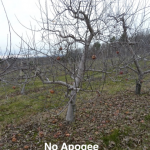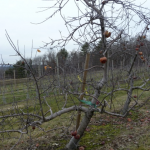HRT-2022-Suggestions for the use of prohexadione-calcium on apples
Prohexadione-calcium (Pro-Ca) was first registered for use in the late 1990s. Pro-Ca is the most important and effective plant growth regulator available to control vegetative growth in apples. As a result of its vegetative growth control property, it can also used extensively to aid in the control of shoot fire blight. The purpose of this Fact Sheet is to update the use of this growth regulator that will allow better and more precise control of vegetative growth and shoot fire blight.
Pro-Ca is a growth regulator that reduces terminal growth by inhibiting the synthesis of gibberellins, a group of endogenous hormones that are largely responsible for regulation of terminal growth in apple trees. Once applied, it requires between 10 and 14 days to slow growth. It is degraded in the tree, so reapplication is generally required after 2.5 to 4 weeks. The total number of applications required in a season will depend on the vigor of the tree, the length of the growing season and the amount of rain an orchard receives during the growing season. In general, two or three applications per year will be required to maintain growth control throughout the growing season.
There are currently two commercial formulations of Pro-Ca; Apogee® (BASF Corporation) and kudos® (Fine Americas, Inc.). Apogee® is a 10% formulation whereas kudos® is a 27.5% formulation. There appears to be no difference in the performance of the two formulations as long as comparable active ingredients are applied. Both products have similar recommendations for what should be placed in the spray tank as to the amount of active ingredient applied, however, the amount of formulated product will differ considerably. Always check the label for appropriate rate of formulated product to be applied.
Apogee label here | Kudos label here | Apogee supplemental 2(ee) label allowing pink application here
Additives used with Pro-Ca
A surfactant is recommended to be included in the spray tank with Pro-Ca. No specific surfactant is recommended although a non-ionic surfactant such as Regulaid® or LI 700® have been and continue to be used successfully. Follow the manufactures rate instructions.
Water hardness and conditioning
Both Pro-Ca products recommend the use of ammonium sulfate (AMS) especially if you have hard water. (You should have your spray water tested for hardness as many pesticides have reduced effectiveness in hard water.) The amount of AMS added to the spray tank should equal the weight of either Apogee® or Kudos® in the tank. Using a water condition such as Quest® or Choice® at a rate of 2 pints per 100 gal in lieu of ammonium sulfate has also been successful. The AMS and water conditioners should be placed in the spray tank first.
Nutrient spray interaction
Pro-Ca should not be applied in a tank containing foliar nutrient sprays. This warning is especially appropriate for calcium chloride and other free calcium-containing products (Agro-K Sysstem-CAL is a notable exception). Chelated calcium and calcium complex formulations appear to be compatible. In the presence of free ionic calcium, Pro-Ca will precipitate in the tank thus clogging the nozzles and screens and will result reduced tree response.
Fruit Set
Fruit set can be expected to increase on trees treated with Pro-Ca. This increase in fruit set is attributed to a reduction in June drop. On Pro-Ca treated trees, we recommend using a more aggressive thinning program than would be normally used.
Time of Application
For more than 15 years the recommended time of the first application was when shoot growth reached 1 to 3 inches. That time of application coincided roughly with petal fall. Recently, it was shown that an initial application of Pro-Ca made at the pink stage of flower development resulted in a much earlier reduction in terminal growth which results in the potential of gaining additional growth control when compared with the petal fall application timing. The reason for this is that growth reduction can be initiated earlier when shoot growth is proceeding most rapidly. This pink application timing is also recognized by plant pathologists as an opportunity to gain earlier shoot fire blight control. Note that a pink application is allowed on the kudos label, however, a supplemental 2EE needs to be on hand to use Apogee at pink.
Amount to Apply
The amount of Pro-Ca to apply is based upon the tree row volume (TRV) of the orchard to be sprayed. The rates recommended on both the Apogee and kudos labels are given in oz/100 gal. On vigorous trees, the amount suggested to be applied is 6 to 12 oz/100 gal. Therefore, in an orchard block with a TRV of 200 gal/acre a grower would apply between 12 and 24 oz of Pro-Ca per acre. Thorough coverage is essential for good growth control so application in less than 100 gal per acre is not suggested. In general, we do not feel that application of more than 6 oz/100 gal is necessary. Growth reduction is not linear with increased Pro-Ca rate.
Recommendations for vegetative growth control
The time of initial application of Pro-Ca for the maximum reduction in growth control is at pink. Using this timing, growth reduction is initiated much earlier, before shoot growth starts to accelerate, which is at about early petal fall. Regardless of when the initial application is made, it requires 10 to 14 days following application for growth control to be initiated. An added benefit of this early application of Pro-Ca is that more lateral shoot growth is controlled, resulting in opening up the tree to greater light penetration. The recommended rate of ProCa to use at this time is 6 oz/100 gal. Generally, a lower rate of Pro-Ca is suggested to be used in the second application which would be about 3 weeks after the initial application on vigorous trees. If less growth control is desired then delaying the initial application a few days is suggested. Often follow up applications of Pro-Ca require only 2 to 4 oz/100 gal.
Quality of fruit on treated trees
In general, we do not feel that ProCa has any direct influence on fruit quality or storage potential in the year of application. Any effects that it may have on fruit can be attributed to indirect effects such as increased fruit set that may manifest itself in smaller fruit at harvest. Some apple varieties seem to be more sensitive to Pro-Ca resulting in russet and cracking of the fruit. Empire in particular is sensitive to Pro-Ca and in general it is not recommended to apply Pro-Ca to Empire.
Use of Pro-Ca to aid in the control shoot fire blight
One of the more important uses of Pro-Ca is to aid in the control of shoot fire blight. It does not have any direct inhibitory effect on the fire blight bacteria, however, it exerts its inhibitory effect by creating a physical impediment to invasion. Pro-Ca slows shoot growth early thus thickening the cells in the new shoots making the shoot more impervious to the entrance of the fire blight bacteria. The inhibition of fire blight begins with the initiation of growth retardation 10 to 14 days after application. If Pro-Ca is applied at pink, fire blight inhibition can be expected to be initiated at about petal fall. Dr. George Sundin at Michigan State University recommends the inclusion of 1 oz/acre Actigard™ with the ProCa to improve fire blight control. His recommendation is to make the Pro-Ca application of 6 oz/100 gal. at the label-suggested timing of when shoots are 1.5 to 3 inches in length. Included in that the Pro-CA spray would be 1 oz/acre of Actigard™ which should be reapplied at 7-8 day intervals. This is necessary to maintain the Actigard™ induction. A total of 3-4 follow up applications of Actigard™ are recommended for shoot blight management. Note that Pro-Ca is NOT a substitute for applying streptomycin at bloom when fire blight infection risk is high! A complete fire blight management program is still necessary.
Pro-Ca use on young trees
Once planted, the goal of fruit growers is to encourage rapid growth of young trees so that trees can fill their allotted space rapidly. But for the first 3 to 4 years after planting young trees are very susceptible to fire blight infection. Since trees are small, it takes very little time for the bacteria to move from the site of infection to the central leader of the tree. If this happens, it is quite likely that the tree will be killed. Therefore, using Pro-Ca to help control shoot blight will require a compromise between fire blight control and growth. A practical solution to this dilemma suggested by Dr. Sundin is to make an application at petal fall using 2 oz/100 gal of Pro-Ca plus 1 oz/acre of Actigard™. The Actigard™ application should be repeated every 7-8 days until the danger of fire blight has passed. Because a low rate of Pro-Ca is used, the inhibitory effect should wear off relatively early, allowing the apple tree to resume growth for the remainder of the summer.




